The Huawei P8 Review
by Andrei Frumusanu on June 4, 2015 8:00 AM EST- Posted in
- Smartphones
- Huawei
- Mobile
- P8
- Kirin 930
WiFi Performance
Moving on to WiFi performance we address one of the most critical faults of the P8: Lack of 5GHz WiFi. There were already some raised eyebrows during the official announcement where we couldn't find any mention of 802.11ac in any of the spec sheets, and indeed, the device comes without support for the higher frequency bands.
This raises some big questions about Huawei's choice of RF back-end and what exactly is going on there. Connectivity itself is provided by a Broadcom BCM4334, which is quite an ancient chipset by today's standards, as we first saw its introduction in 2012. Broadcom advertises max PHY rates of up to 150Mbps and upper layer rates of up to 90Mbps - and 5GHz is definitely listed as one of its capabilities. This is the same chip used in the Honor 6 and Mate 7, which did have 5GHz capability. In the end only Huawei knows what kind of decision-making process warranted such a significant omission of an every-day important feature.
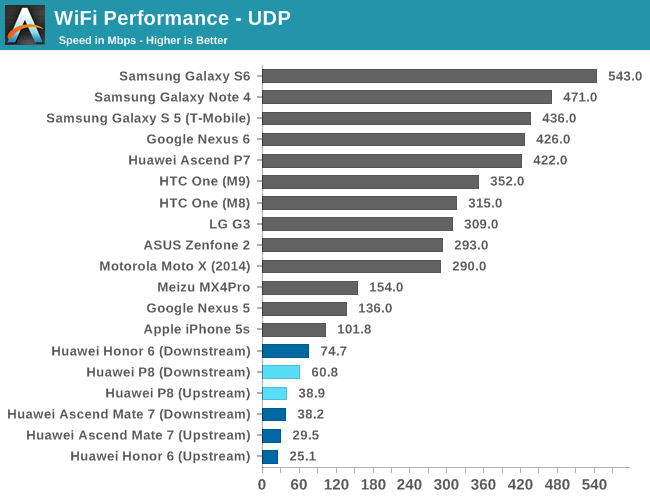
The Honor 6 and Mate 7's WiFi performances still leave a bitter taste due to their bad WiFi performances, and the P8 does little to sweeten the deal. Yet again we see atrocious numbers from the affected devices. A especially very weird characteristic that can only be found on the Huawei devices is that we see discrepancies between downstream and upstream transfer speeds, as transfers in the downstream direction are consistently faster than upstream data transfers.
I suspected there was some software reason as to why this happened back when reviewing the H6 and MT7, but couldn't confirm it as Huawei hadn't released the source code for the devices yet. Since then, they did manage to comply to GPL and make the kernel sources available.
While searching through Broadcom's DHD driver to see what changes Huawei/HiSilicon have made, one notable change that I stumbled upon, although not related to the bad WiFi speeds, was their network traffic DVFS mechanism. This has nowdays become quite of a standard in modern devices as vendors try to improve latency and response-time of devices. Most notably Samsung has a very robust framework that boosts CPU and memory frequency when detecting spikes in network and NAND throughput (Among others). It's interesting to see how these quality-of-service mechanism gain popularity among vendors.
In the end the software assumption just didn't work out. Simply gripping the phone in-hand will reduce the transfer speeds by a third, clearly pointing out that this is an antenna/RF issue and not a software bottleneck or bandwidth throttling.
GNS Performance
I wasn't able to fully determine what silicon provides the GPS functionality for the P8, but I suspect it is the Kirin SoC and its integrated Balong modem have a play in it.
No matter who provides the chip solution, the end-result is what counts. Here the P8 performs very well by being able to capture a large number of satellites at high strength. Cold lock-on without AGPS assistance took 39 seconds, while with pre-cached location data the P8 was able to have a location fix in under 3 seconds.
NAND Performance
NAND performance was again one of the weak spots of previous Huawei devices, with the H6 and MT7 using quite old eMMC units that were also used back in the Galaxy S3. The P8 remedies this by using a faster SanDisk SDW16G unit.
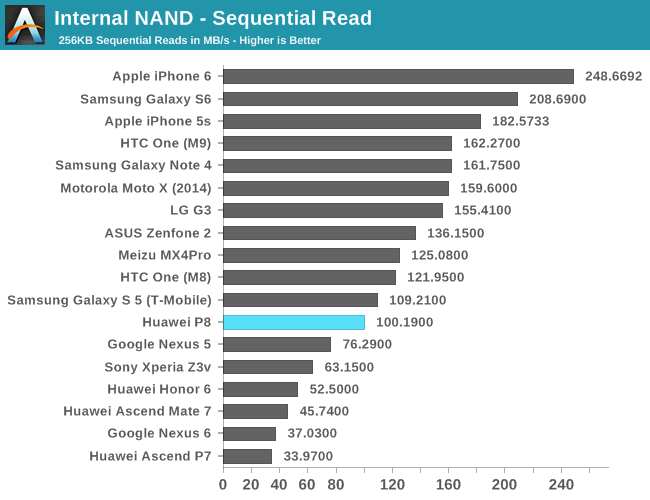
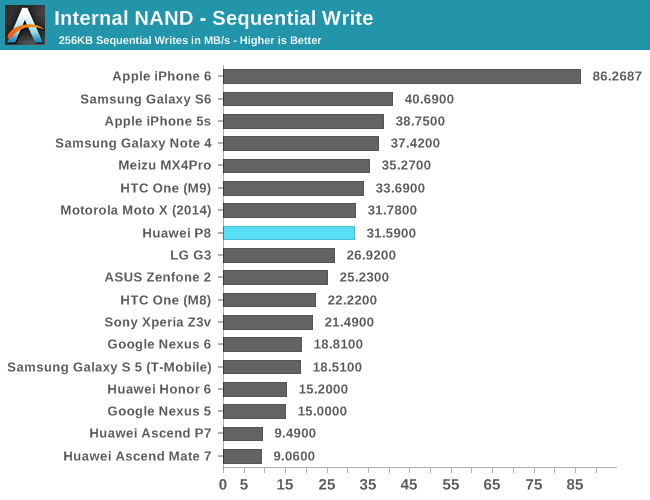
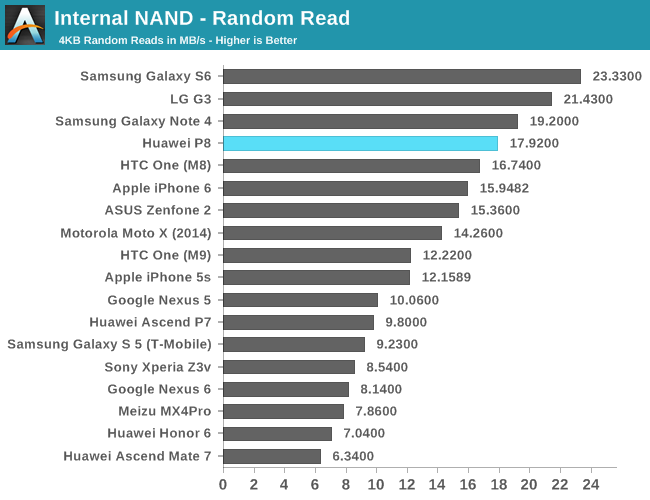
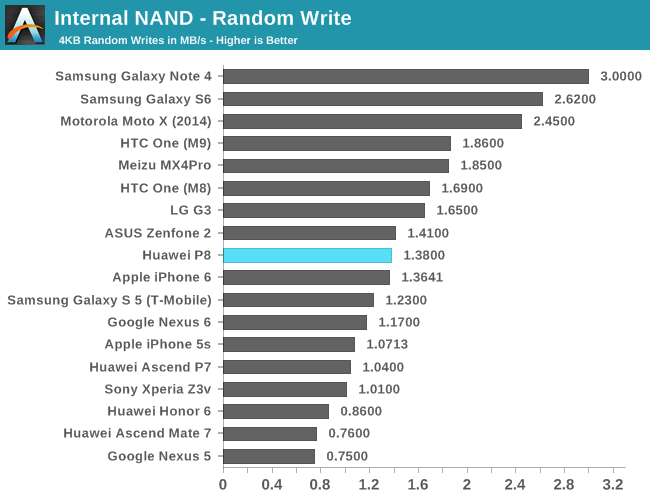
While the new eMMC doesn't break any records, it's now among the "average" performing devices out there, as opposed to the horrendous performances of the Mate 7 and Honor 6.











104 Comments
View All Comments
lilmoe - Thursday, June 4, 2015 - link
You guys have probably covered this, but why is UFS on your charts not showing the speed bumps it's showing in benchmarks on other sites? Is it a benchmark software issue, or is that the actual speed you're achieving?tipoo - Thursday, June 4, 2015 - link
One of their previous reviews said they were using an older test that only used a single thread to address IO, which gimped the UFS in the Galaxy S6. I'm not sure if they're still doing that.I don't think they should though - they said it was because the iPhones test was single threaded, but that's not the tests problem, HFS+ only allows one IO thread to access the file system at a time. Dumb for a file system in 2015, but there it is.
JoshHo - Thursday, June 4, 2015 - link
In the time since the Galaxy S6 review we've discussed the effects of multithreaded IO and it has become apparent that this ends up impacting normal eMMC results in an unrealistic manner due to controller overhead as IO in real world applications is treated as a critical section. Combined with the need to maintain comparable tests across Android and iOS, we've decided to continue focusing on single threaded IO performance for internal storage testing.Brakken - Friday, June 5, 2015 - link
I don't understand what you wrote except that the GS6 multithreading is a dog's breakfast. Is this correct?tipoo - Wednesday, June 10, 2015 - link
That's not what he was getting at. Just that multithreaded I/O requests benefit the GS6 UFS flash system while hurting the performance of every other phone, so they decided to stay with the older single threaded test.der - Thursday, June 4, 2015 - link
YESSSSSSSSSSSSSSSSSSSSSSSSLONG AWAITED REVIEW!
tipoo - Thursday, June 4, 2015 - link
Looks like another disappointment from them. Shame, it's gorgeous on the outside, but I wish they'd just go with another SoC maker until they can produce something decent. Heck, go with Intel, the Z3560 in the Zenfone 2 both stomps this and comes practically free.daar - Thursday, June 4, 2015 - link
Why no comparison with the iPhone 6? Isn't it generally the reference phone for photos?That said I disagree with the P6 low light performance, the greater noise is more of a problem overall than the odd slight smudging in the S6. For example, in the picture with the streets and car, you can easily make out the license plates with the S6, on the P6 you can't.
Andrei Frumusanu - Thursday, June 4, 2015 - link
I currently don't have an iPhone 6 to use as a reference phone, so the S6 had to make due.Ethos Evoss - Friday, June 12, 2015 - link
so why u putting it in your weird graphs and charts ? all fake ! as I said !